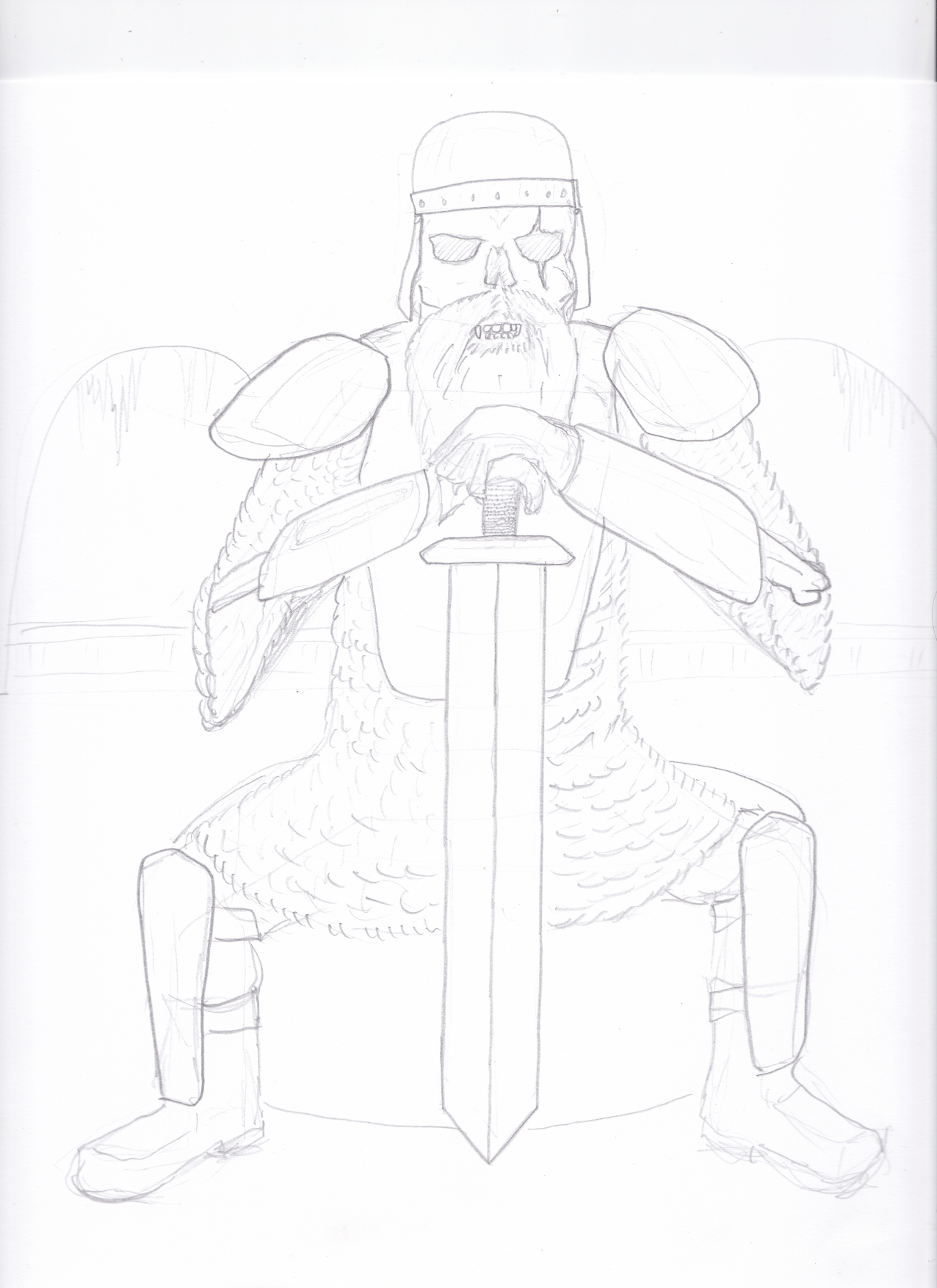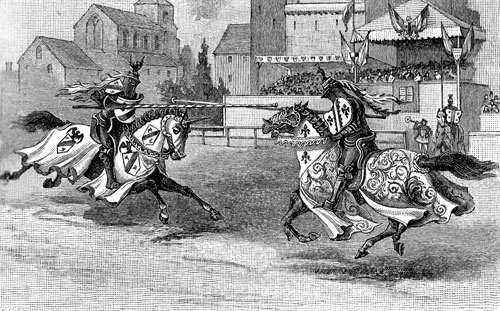Dwarven Death Knight
Medium undead, lawful evil
Armor Class 19 (plate armor), 21 (shield of faith)
Hit Points 67 (8d8+24)
Speed 25 ft.
Proficiency +3
STR 19 (+4) DEX 10 (+0) CON 16 (+3) INT 10 (+0) WIS 12 (+1) CHA 15 (+2)
Saving Throws Dex +3, Wis +4, Cha +4
Damage Resistances fire
Damage Immunities poison; necrotic
Condition Immunities charmed, exhausted, frightened, poisoned
Senses passive Perception 11, darkvision 120 ft.
Languages Common, Dwarven
Challenge 6 (2,300 XP)
Actions
Multiattack. The death knight makes two Frost Brand attacks.
Frost Brand. Melee greatsword: +7 to hit, reach 5 ft., one creature. Hit: 7 (2d6 + 4 slashing and 1d6 cold damage).
Spellcasting. The death knight is a 8th level spellcaster. Its spellcasting ability is Charisma (spell save DC 13, +5 to hit with spell attacks). It has the following spells prepared:
1st level: (4 slots): shield of faith, thunderous smite, bless, searing smite
2nd level: (3 slots): aid, branding smite

Posted in 5th edition Dungeons & Dragons, Character, Creature, Uncategorized by Adam A. Thompson with no comments yet.
Jäällätaudin the Ice Tongue
The History: This ancient blade’s full history is known only to the most studious Dwarven sages of the Dunheng Kingdoms, where it was forged to slay giants and dragons. In the centuries since, it has appeared in the hands of many heroes, only to be lost again with their passing. Most recently it was wielded by Jak, a King of the Fridon people who in tales is called the Giant Slayer. He was a king of the Fridon many years ago, when his people were attacked by the giants from the Danor Mountains. He fought them wearing the hide of a dragon and wielding Jäällätaudin, and drove them back to their burning peaks.
Below are statistics for Jäällätaudin using 5th edition Dungeons & Dragons rules. To customize it add some of the magic item quirks from the Dungeon Master’s Guide. Or alter these stats or add abilities to make it fit into your campaign.
Weapon (greatsword), very rare (requires attunement)
This thick-bladed, angular greatsword is a masterpiece of dwarven artistry. You gain a +1 bonus to attack and damage rolls made with this magic weapon. Against creatures with Damage Immunity to fire, the bonus is instead +3.
Sentient
Jäällätaudin is sentient, and is only interested in slaying dragons, and giants, or other fire-type creatures (salamanders, fire elementals, etc.). It will communicate its history through nightly dreams (telepathy), where the wielder lives through the many battles that the sword’s previous owners fought. If its wielder does not actively peruse the killing of its foes, a deep chill comes over the wielder and they must succeed on a DC 20 Constitution saving throw or become fatigued and vulnerable to cold damage until the sword is convinced the wielder will do as it wishes.
Many times in the past, this compulsion has driven the sword’s wielders to their doom, for no warrior survives every fight. Other times stubborn warriors resisted the sword’s commands, discarding it in an icy ravine or mountain lake. Twice those who could not leave the sword behind died from the cold, buried under a slowly-growing ice.
Cursed
This sword’s driving purpose and blood-soaked past have coalesced into a curse – no one, once attuned, may voluntarily discard the blade unless they succeed on a DC 20 Charisma saving throw.
Posted in 5th edition Dungeons & Dragons, Fantasy, Magic Item, Uncategorized by Adam A. Thompson with no comments yet.
5th edition Dungeons & Dragons Combat Critical Fumble Rules
I like critical fumbles in my D&D game. They increase randomness, speed up combat, and create tension and chaos on the battlefield. For me it’s a significant part of the fun of the game, so I use a critical fumble rule for combat when I’m the Dungeon Master or Referee.
So here’s my house rule: when someone rolls a 1 on an attack roll, they have to roll a d20 again to see how bad the fumble is:
20 – Recovery – the fumble has no major ill effect (feel free to make up some comical reason why)
16-19 – Over-swing – disadvantage on fumbler’s next attack roll
12-15 – Miss-step – advantage on the next attack against fumbler
9-12 – Fall Down – fumbler falls prone
5-8 – Drop Weapon – fumbler drops weapon, or else is dazed next round
4-2 – Wild Swing – attack self or ally (attacking player makes new attack roll)
1 – The Gods Frown – attack self or ally with advantage (attacking player makes new attack rolls), or something equally disastrous
The basic idea is, if you roll a 1, something bad happens. Not only have you failed, but your situation has gotten worse somehow.

I used to use a different simple critical fumble table, where the results were basically a d4, and the lower you rolled the worse it was. I like it because it’s easy to memorize and use without having to refer to a table.
The above table is expanded to use the full numerical granularity of a d20. It also uses the “rolling 20 is good, rolling 1 is bad” game design element.
D4 Fumble Table
4 – off balance – enemies have advantage to attack you next round
3 – fall down – fall prone
2 – drop weapon – drop weapon or are dazed next round
1 – bad swing – attack self or ally
There have been a lot of critical fumble rules published, but recently I’ve seen a fun idea about how to handle fumbles. On the Moisture Farmer’s podcast, I heard them using a new-to-me critical fumble rule. Not only is it great for it’s simplicity, but also for the opportunity to be creative.
If a player rolls a 1, the GameMaster decides what happens to the player’s character. When a GameMaster rolls a 1, the players decide what happens to the GameMaster’s character. So when the GM fumbles, the players get to narrate what happens. When a player fumbles, the GM gets to narrate it.
No boundaries are needed, but as a DM, I’d probably usually limit to to, at worst, damaging your own character or an ally. If the players always end up demanding the the monsters fall on their swords and die, then it would be reasonable for the DM to decide the same thing happened to the PCs. So there’s an opportunity to do some creative role-playing and cooperate to keep things “in bounds”.
Do you use critical fumbles in your game? Why or why not? Let us know in the comments below.
Posted in 5th edition Dungeons & Dragons, d20 Future, D20 Modern, Gamma World, Uncategorized, Variant Rules and tagged critical fumble by Adam A. Thompson with no comments yet.